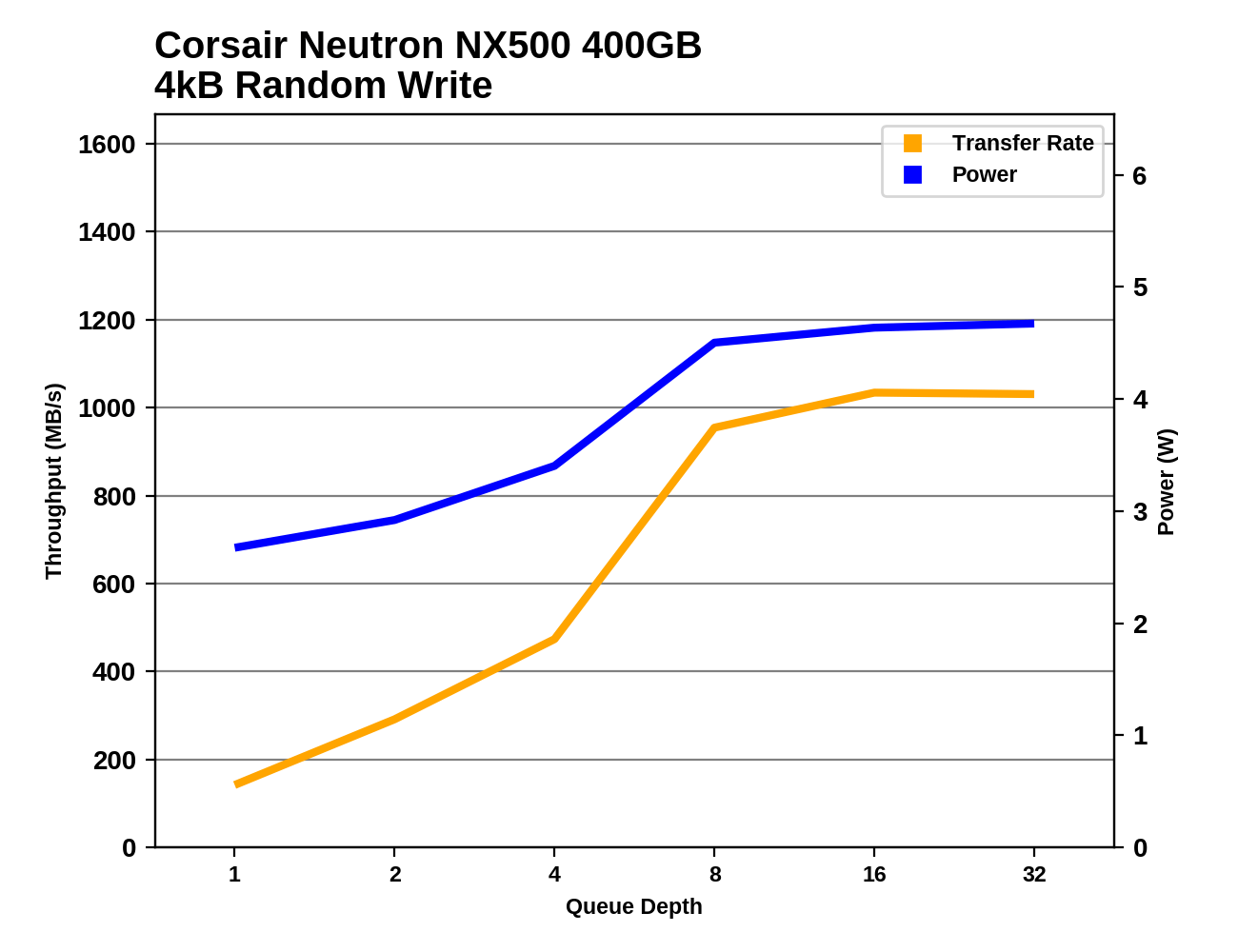The Corsair Neutron NX500 (400GB) PCIe SSD Review: Big Card, Big Pricetag
by Billy Tallis on August 16, 2017 10:00 AM ESTRandom Read Performance
Our first test of random read performance uses very short bursts of operations issued one at a time with no queuing. The drives are given enough idle time between bursts to yield an overall duty cycle of 20%, so thermal throttling is impossible. Each burst consists of a total of 32MB of 4kB random reads, from a 16GB span of the disk. The total data read is 1GB.

The QD1 burst random read speeds of the Phison E7 drives are all over the chart. The Corsair Neutron NX500 ranks just above the middle, while the Patriot Hellfire is the second-fastest drive in the bunch. With the exception of the underperforming Zotac SONIX and the SATA-based 850 PRO, this chart shows clear separation between the MLC and TLC drives.
Our sustained random read performance is similar to the random read test from our 2015 test suite: queue depths from 1 to 32 are tested, and the average performance and power efficiency across QD1, QD2 and QD4 are reported as the primary scores. Each queue depth is tested for one minute or 32GB of data transferred, whichever is shorter. After each queue depth is tested, the drive is given up to one minute to cool off so that the higher queue depths are unlikely to be affected by accumulated heat build-up. The individual read operations are again 4kB, and cover a 64GB span of the drive.

On a longer test that includes some moderately higher queue depths, the NX500 comes out on top among the Phison E7 drives, but it is a bit below average compared to the market as a whole.

The power efficiency of the NX500 is not quite competitive with the Patriot Hellfire M.2, and nowhere close to most of the 3D NAND SSDs.
 |
|||||||||
The Corsair Neutron NX500's random read performance scales at higher queue depths much better than the other Phison E7 SSDs, but even at QD32 it is slower than Toshiba's own OCZ RD400 using the same NAND.
Random Write Performance
Our test of random write burst performance is structured similarly to the random read burst test, but each burst is only 4MB and the total test length is 128MB. The 4kB random write operations are distributed over a 16GB span of the drive, and the operations are issued one at a time with no queuing.

The burst random write speed of the Corsair Neutron NX500 is far below what it should be. Both of the other Phison E7 drives are substantially faster and yet still slower than even the Intel SSD 600p.
As with the sustained random read test, our sustained 4kB random write test runs for up to one minute or 32GB per queue depth, covering a 64GB span of the drive and giving the drive up to 1 minute of idle time between queue depths to allow for write caches to be flushed and for the drive to cool down.

With a longer test and bringing in some higher queue depths, the Intel 600P and WD Black fall below the NX500, but the NX500 is still performing much worse than the other Phison E7 SSDs or any other MLC NVMe SSD. The Patriot Hellfire is basically tied for second place behind Samsung.

The NX500's power efficiency during random writes isn't great, but it's only slightly worse than some of the competing NVMe MLC drives and is substantially better than the entry-level NVMe TLC drives.
 |
|||||||||
The NX500's random write speed does reach decent levels at queue depths of 8 or higher, but at the low queue depths that matter for real-world desktop performance, the NX500 is way behind.










45 Comments
View All Comments
damianrobertjones - Thursday, August 17, 2017 - link
Opens Amazon/ebay and types 'Toshiba XG5'. Nothing found. Oh well you've lost a possible sale Toshiba! Well done. (U.K.)mapesdhs - Thursday, August 17, 2017 - link
Get a 960 Pro instead, far better buy. My 512GB was only 249 UKP new.Or if you want to save some pennies, look for an SM951, SM961 or the older 950 Pro.
Billy Tallis - Thursday, August 17, 2017 - link
The XG5 is an OEM drive. They're selling every single one they can manufacture to companies like Dell. We'll see a retail counterpart eventually, once their BiCS3 manufacturing volume ramps up.wazoo42 - Thursday, August 17, 2017 - link
What happened to the performance consistency tests? Those were one of the primary reasons I went to Anand for SSD reviews.Billy Tallis - Thursday, August 17, 2017 - link
They'll be back eventually. I'm currently keeping the testbed busy around the clock with all the new drives that have arrived recently, plus re-testing older drives on the new 2017 test suite. The steady-state performance consistency test was the least realistic benchmark on the old 2015 test suite, so its replacement in the 2017 suite is my lowest priority. Once the testbed has some idle time, I'll go back and run the steady-state performance consistency tests on everything.In the meantime, the ATSB tests do have consistency scores in the form of 99th percentile latency, including broken down by reads and writes. I'm also considering adding some form of consistency score to the synthetic benchmarks that are already in this review.